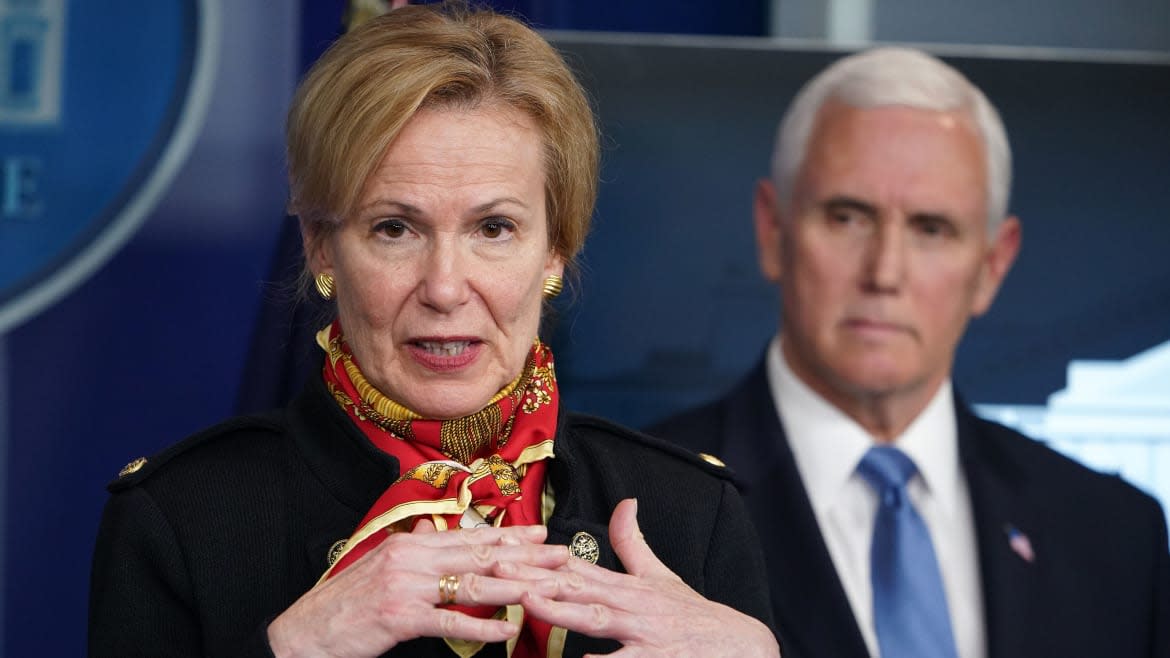White House Trots Out Grim Death Models to Drive Home Social Distancing

Americans on Tuesday got their first official glance at the statistical models used in recent weeks by federal officials to guide the country toward an economic shut down, implement social-distancing guidelines, and ask more than 250 million people to stay home.
During a press briefing at the White House, Dr. Deborah Birx, the White House coordinator for its coronavirus task force, spoke about various predictive models that warned of as many as 1.5 million to 2.2 million people in the United States succumbing to this virus, without mitigation.
Birx had previously said that the national death toll could reach between 100,000 to 200,000, even in a world where all of the federal social-distancing guidelines were followed “perfectly.”
One particular model, out of the University of Washington, Birx said Tuesday, “assumes full mitigation”—including social distancing—and uses information from all over the United States. It is adjusted every morning with new data, she said, and depends on the behavior of the population at large.
“This is done community by community,” said Birx. “We’re very dependent on each person in the United States… following the presidential guideline to a tee.”
Another Pastor Charged With Defying Coronavirus Orders Against Large Gatherings
In other words, the models being used by the task force are standard epidemiological tools—but their results vary based on how well social-distancing guidelines are followed, as The New York Times previously reported. And President Trump’s decision to extend those guidelines through April 30 came after he viewed at least 12 different models, Birx has said.
One model mentioned by the White House on Sunday projected that more than 2,000 people could die each day in the U.S. through April 15, when the country might hit “peak resource use,” requiring 224,000 hospital beds—61,000 more than are available, according to CNN. The model, created by the University of Washington's Institute for Health Metrics and Evaluation, uses information from state and national governments, hospital groups, and the World Health Organization. It predicts approximately 83,967 deaths by August, even if social-distancing continues through May.
Other, more dire models, paint an even worse picture. One projection, from the Imperial College COVID-19 Response Team, provided the figure suggesting that without action to suppress cases, 2.2 million Americans might die.
After months spent watching China—and then the rest of the world—scramble to beat back the skyrocketing number of infections, the U.S. made key missteps in preparing its public for the pandemic. And this week, the U.S. eclipsed the highest number of total infections in the world at well over 150,000, even with a serious shortage of diagnostic kits and admissions about how drastically that tally may be undercounting the actual number of cases across the country.
The American toll was at least 3,606 deaths as of late Tuesday afternoon, overtaking China’s 3,305 COVID-19-related fatalities—even as those Chinese figures have come under heavy scrutiny.
The outbreak in New York state remained the largest in the nation, with more than 1,200 deaths. Gov. Andrew Cuomo has repeatedly warned that the peak is still ahead. “I want to prepare for that apex, because this virus has been ahead of us every step of the way,” Cuomo has told reporters.
Asked by reporters at the White House Tuesday about whether Americans should expect to see 100,000 people die from the virus, Dr. Anthony Fauci, the director of the National Institute of Allergy and Infectious Diseases, replied: “As sobering a number that is, we should be prepared for it.”
But Dr. Jeffrey Klausner, an adjunct professor of epidemiology at the University of California Los Angeles who previously worked for the CDC, cautioned against panicking at the various models being cited, even by the White House.
“To say that 100,000 will die, that means 150 times that—you’d have to reach a level of 15 million infected—which would mean we’d have to see transmission patterns like influenza,” Klausner told The Daily Beast, citing a new estimated mortality rate of 0.66 percent, which was reported on Tuesday.
“I’m highly skeptical of that estimate,” Klausner said, noting that numbers like those will “perpetuate panic” and are “potentially misleading and not particularly helpful.”
“With this virus, every epidemic is local,” added the epidemiologist, arguing that useful projections should be local—and based on local numbers. “We need local data to drive local policy.”
“I would hope these estimates do not cause panic, but reinforce the need to practice and continue social distancing,” said Dr. David Larsen, an associate professor in the Department of Public Health at Syracuse University. “The higher estimates of potential mortality can be avoided if we continue to fight this virus through social distancing. I also think wearing masks in public will help.”
Larsen acknowledged to The Daily Beast that the numbers are “scary,” adding: “I would be surprised if many Americans are operating without a low-grade anxiety right now.”
“But we should not panic,” said Larsen. “We will get through this.”
Fauci urged similar caution when speaking to CNN on Sunday, even as he cited models that projected between 100,000 and 200,000 deaths due to the virus.
“I don’t want to be held to that,” said Fauci. “I just don't think that we really need to make a projection when it's such a moving target that you can so easily be wrong and mislead people.”
Still, it was clear at Tuesday’s press conference that the models were meant to drive home the importance of social-distancing and other forms of mitigation, which Fauci called “the answer to our problems.”
Vice President Pence, the head of the White House’s task force, added: “We have reason to believe that it’s working.”
Got a tip? Send it to The Daily Beast here
Get our top stories in your inbox every day. Sign up now!
Daily Beast Membership: Beast Inside goes deeper on the stories that matter to you. Learn more.

 Yahoo News
Yahoo News 
